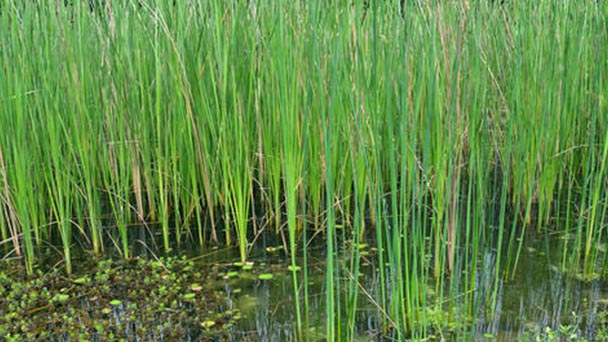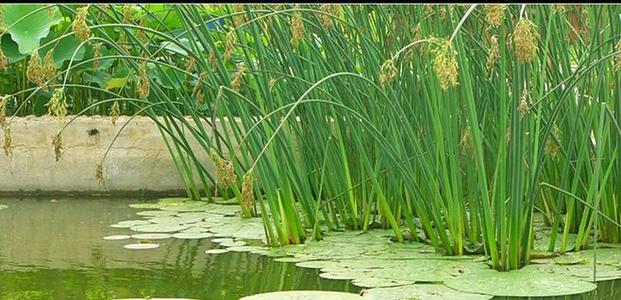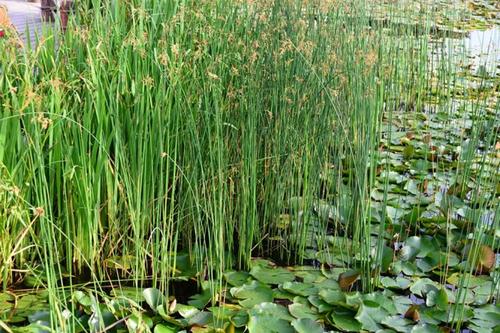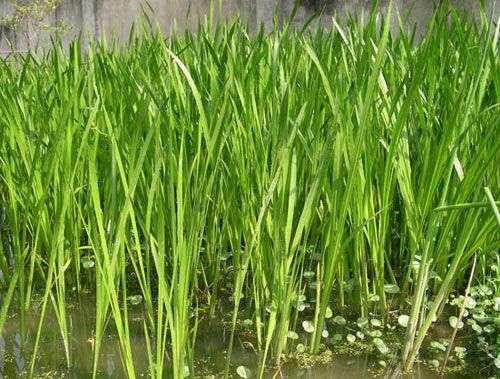Softstem bulrush profile
Written by Maggie
Dec 18 2020

Softstem Bulrush is produced in many provinces of China; Growing near lakes or shallow ponds. It’s also distributed in Korea, Japan, Australia, North and South America. It is cultivated in Beijing as an ornamental. The stem is often taken as the material for the compound at Yunnan.
Softstem Bulrush picture

Softstem Bulrush morphological characteristics
Softstem Bulrush stolon rhizome stout with many fibrous roots. Culms are tall, terete, 1-2 m tall, smooth, base with 3-4 leaf sheaths, up to 38 cm long, tubular, membranous, uppermost with a leaf blade.Leaf blade linear, 1.5-11 cm long.
Softstem Bulrush Bracts are elongate to culms, erect, drillate, often shorter than inflorescence, few slightly longer than inflorescence; Cymes are of the long side branches are simple or comeback, pseudo rice, with 4-13 or more radiating branches; Radiating branches are up to 5 cm long, convex on one side, concave on the other, serrate on the edge; The spikelet is solitary or 2-3 clustered at apex of radiating branches, ovate or oblong, apically acute or obtuse, 5-10 mm long, 2-3.5 mm wide, with many flowers; Scales are elliptic or broadly ovate, apex slightly concave, shortly apical, membranous, ca. 3 mm long, brown or purplish brown, sometimes pale at base, abaxially raised by rust, veins 1, margin ciliate; softstem bulrush lower bristles are as long as small nuts, reddish brown, barbs; Softstem Bulrush has 3 stamens, anthers linear, septum prominent; The style is medium long, stigma 2, 3, longer than style.
Nutlets are obovate or elliptic, doubly convex, rarely triangular-shaped, ca. 2 mm long. Softstem Bulrush flowering period: June - September.
Habitat of Softstem Bulrush
Softstem Bulrush is produced in northeast China, Inner Mongolia, Shanxi, Shaanxi, Gansu, Xinjiang, Hebei, Jiangsu, Guizhou, Sichuan, Yunnan;Also distributed in Korea, Japan, Australia, North and South America. Softstem Bulrush grows in shallow ponds, swamps, or marsh grass.
Softstem Bulrush growth habit
Softstem Bulrush grows best at 15-30℃ and stops growing below 10℃. Softstem Bulrush can withstand low temperature, most of the northern areas can be open to the winter.

Softstem Bulrush propagation method
Sow
Seeds are usually sown indoors between March and April. The pot on the culture soil is flattened and compacted, and seeds are sown on the pot. A layer of fine soil is put on the sieve to cover the seeds. The pot is shallow submerged in water, so that the pot soil is always soaked. Softstem Bulrush can germinate and take root in about 20 days when the room temperature is controlled at 20-25℃.
The best way to disinfect the substrate used for sowing is to put it in a pan and fry it hot. Any disease or insect can be scalded to death. Soak the Softstem Bulrush seeds in warm water (about the same temperature as washing your face) for 12 to 24 hours, until they absorb water and swell. This should not be done for the most common seeds that germinate easily. For small seeds that are hard to pick up by hand or other tools, you can wet one end of the toothpick with water, stick the seeds one by one on the surface of the matrix, covering the matrix 1 cm thick, and then put the seeded pot into the water, the depth of water is 1/2 to 2/3 of the height of the pot, let the water slowly soak up. For larger Softstem Bulrush seeds that can be picked up by hand or with other tools, place the seeds directly in the matrix and sow at intervals of 3 x 3 cm.After sowing, the substrate was covered and the covering thickness was 2-3 times of seed grain.After sowing. Spray can be used, find original sprinkle the seed matrix wet, later when the pot soil slightly dry then dowsing water, still should pay attention to watering the strength can not be too large, so as not to rush up the seeds;
Management after sowing: After sowing in the autumn, when the cold wave low temperature, you can use plastic film to wrap the flowerpot, in order to keep heat and moisture; Expose the membrane to the sun before 9:30 a.m. or after 3:30 p.m., otherwise the seedlings will grow very weak. When most of the seeds have come out. The seedlings should be thinnest properly: the sick and unhealthy seedlings should be pulled out, so that there is a certain space between the remaining seedlings. When most seedlings have three or more leaves, they can be transplanted to the pot.
Division
When the weather gets warmer in early spring, dig the overwintering seedlings from the ground, shake off part of the soil, and divide the underground stems into several clumps with 5-8 stems in each cluster with a branch shear or shovel. Plant Softstem Bulrush into a pot without drainage holes, and keep the soil moisture or shallow water, 10-20 days can be germinated. For open field cultivation, 8-12 buds should be kept in each cluster. In the open-field cultivation, select the appropriate location in the water scenic spot, dig holes and plant clumps with the spacing of 25 cm ×36 cm. If sufficient fertilizer is provided in the same year, vigorous growth can be achieved and connected into pieces. Potted Softstem Bulrush can be used for garden display. Choose 30-40 cm diameter flower pots with no drainage holes. After planting, compacted the soil and filled it with water.
Sink water potted namely the pot immersed in water, stem out of the water, growth stage water level is higher than the basin surface 10-15 cm; Softstem Bulrush like fertilizer, if the base fertilizer is insufficient, can be in the growth period topdressing 1-2 times, mainly with nitrogen fertilizer as the main combination of phosphorus, potassium applied. The cultivated water level of submerged potted scallion should change in different periods. The initial water level is 5-7 cm higher than the basin surface. It is better to irrigate with sunburned water to improve the water temperature and facilitate the germination and growth. In the growing season, the water surface is 10-15 cm above the basin surface; We should clear weeds inside the basin in time and surface lichen, can choose to have the weather of wind, when lichen or duckweed is blown to pool horn by the wind, concentration salvage is cleared. Before the start of winter, cut off some withered stems on the ground, place the pot in the cellar for winter, and keep the pot soil moist.

Softstem Bulrush main value
Ecological
Softstem Bulrush has a high removal rate of organic matter, ammonia nitrogen, phosphate and heavy metals in sewage.
Other
Softstem Bulrush is cultivated in Beijing for ornamental use. The stem is often taken as the material for the compound at Yunnan.
Latest Updated
- Benefits of Bugleweed - 7 Science-backed Health Benefits
- Bugleweed Dangers & Side Effects - Is It Poisonous?
- How to Plant Evergreen Trees - What You Should Know
- When to Plant Evergreens - Grow Guide for Evergreen Trees
- 12 Wonderful Evergreen Shrubs for Your Garden
- 12 Popular Evergreen Plants with Pictures for Beginners
- When And How To Prune A Lilac Bush Like a Pro
- How to Grow & Care for Lilac Vine (Hardenbergia Violacea)
- Japanese Lilac Tree (Syringa Reticulata) Care & Propagation Guide
- Shumard Oak Pros and Cons - What to Know
Popular Articles
- Winter maintenance of Antirrhinum Majus
- How to Grow Terminalia Mantaly Tree
- How to Grow and Care for Crossostephium Chinense
- How to grow Antirrhinum Majus in spring
- Peristeria Elata (Dove Orchid) Profile: Info & Care Guide
- Underwatered Snake Plant (Sansevieria Trifasciata) - Signs And How To Fix
- How to Care for Brazilian Jasmine Plant (Mandevilla Sanderi)
- How to Grow & Care for Graptopetalum Purple Delight in Summer
- Rosa Chinensis (China Rose): Plant Growing & Care Tips
- How to Care for Baby Sun Rose (Aptenia Cordifolia)